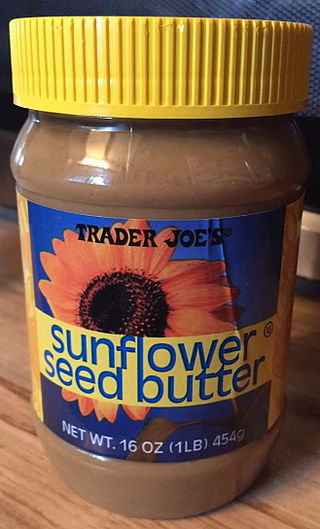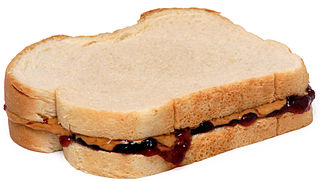
Nutella is a brand of brown, sweetened hazelnut cocoa spread. Nutella is manufactured by the Italian company Ferrero and was introduced in 1964, although its first iteration dates to 1963.

The peanut, also known as the groundnut, goober (US), pindar (US) or monkey nut (UK), is a legume crop grown mainly for its edible seeds. It is widely grown in the tropics and subtropics, important to both small and large commercial producers. It is classified as both a grain legume and, due to its high oil content, an oil crop. World annual production of shelled peanuts was 44 million tonnes in 2016, led by China with 38% of the world total. Atypically among legume crop plants, peanut pods develop underground (geocarpy) rather than above ground. With this characteristic in mind, the botanist Carl Linnaeus gave peanuts the specific epithet hypogaea, which means "under the earth".

The cashew tree is a tropical evergreen tree native to South America in the genus Anacardium that produces the cashew seed and the cashew apple accessory fruit. The tree can grow as tall as 14 metres, but the dwarf cultivars, growing up to 6 m (20 ft), prove more profitable, with earlier maturity and greater yields. The cashew seed is commonly considered a snack nut eaten on its own, used in recipes, or processed into cashew cheese or cashew butter. Like the tree, the nut is often simply called a cashew. Cashew allergies are triggered by the proteins found in tree nuts, and cooking often does not remove or change these proteins.

Peanut butter is a food paste or spread made from ground, dry-roasted peanuts. It commonly contains additional ingredients that modify the taste or texture, such as salt, sweeteners, or emulsifiers. Consumed in many countries, it is the most commonly used of the nut butters, a group that also includes cashew butter and almond butter.

Planters Nut & Chocolate Company is an American snack food company now owned by Hormel Foods. Planters is best known for its processed nuts and for the Mr. Peanut icon that symbolizes them. Mr. Peanut was created by grade schooler Antonio Gentile for a 1916 contest to design the company's brand icon. The design was modified by a commercial artist and has continued to change over the years.

Jif is an American brand of peanut butter made by The J.M. Smucker Company, which purchased the brand from Procter & Gamble in 2001.

Skippy is an American brand of peanut butter spread manufactured in the United States and China. First sold in 1932, Skippy is currently manufactured by Hormel Foods, which bought the brand from Unilever in 2013. It is the best-selling brand of peanut butter in China and second only to the J.M. Smucker Company's Jif brand worldwide.

Peter Pan is an American brand of peanut butter that is marketed by Post Consumer Brands, part of Post Holdings, and is named after the J. M. Barrie character. The product was introduced by Swift & Company in 1920 under the name "E. K. Pond" and renamed in 1928.

A nut butter is a spreadable foodstuff made by grinding nuts into a paste. The result has a high fat content and can be spread like true butter, but is otherwise unrelated. Nut butters include:

A spread is a food that is spread, generally with a knife, onto foods such as bread and crackers. Spreads are added to food to enhance the flavor or texture of the food, which may be considered bland without it. Butter and soft cheeses are typical spreads.

Almond butter is a food paste made from grinding almonds into a nut butter. Almond butter may be "crunchy" or "smooth", and is generally "stir" or "no-stir" (emulsified). Almond butter may be either raw or roasted, but this describes the almonds themselves, prior to grinding.

Mixed nuts are a snack food consisting of any mixture of mechanically or manually combined nuts. Common constituents are peanuts, almonds, walnuts, Brazil nuts, cashews, hazelnuts (filberts), and pecans. Mixed nuts may be salted, roasted, cooked, or blanched.
Hazelnut butter or hazelnut paste is a food spread made from crushed and blended hazelnuts. More commonly found in Europe, hazelnut butter is also familiar when mixed with chocolate as an ingredient in chocolate spreads. Hazelnut butter is available in both crunchy and smooth varieties, and can be made from either raw or roasted hazelnuts. Gianduja is also a type of chocolate stretched with hazelnut butter.

Sunflower butter, also known as sunflower seed butter, is a food paste made from sunflower seeds. Sunflower butter is commonly used as a substitute for peanut butter when allergies are a concern.

A peanut butter and jelly sandwich (PB&J) consists of peanut butter and fruit preserves—jelly—spread on bread. The sandwich may be open-faced, made of a single slice of bread folded over, or made using two slices of bread. The sandwich is popular in the United States, especially among children; a 2002 survey showed the average American will eat 1,500 peanut butter and jelly sandwiches before graduating from high school. There are many variations of the sandwich, starting with the basic peanut butter sandwich or jam sandwich.

Peanut flour is made from crushed, fully or partly defatted peanuts. Peanut flour, depending on the quantity of fat removed, is highly protein-dense, providing up to 52.2 grams (1.84 oz) per 100 grams (3.5 oz). Culinary professionals use peanut flour as a thickener for soups, a flavor and aromatic enhancer in breads, pastries and main dishes.

The Leavitt Corporation is a manufacturer of nuts and peanut butter, formed by Michael Hintlian in 1925. Its manufacturing facility is in Everett, Massachusetts. Leavitt has about 100 employees.















